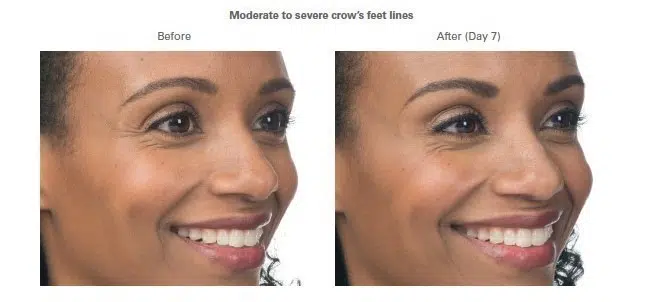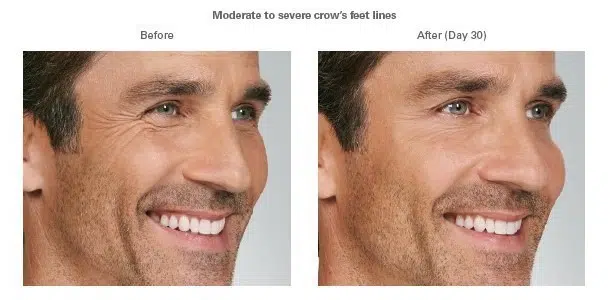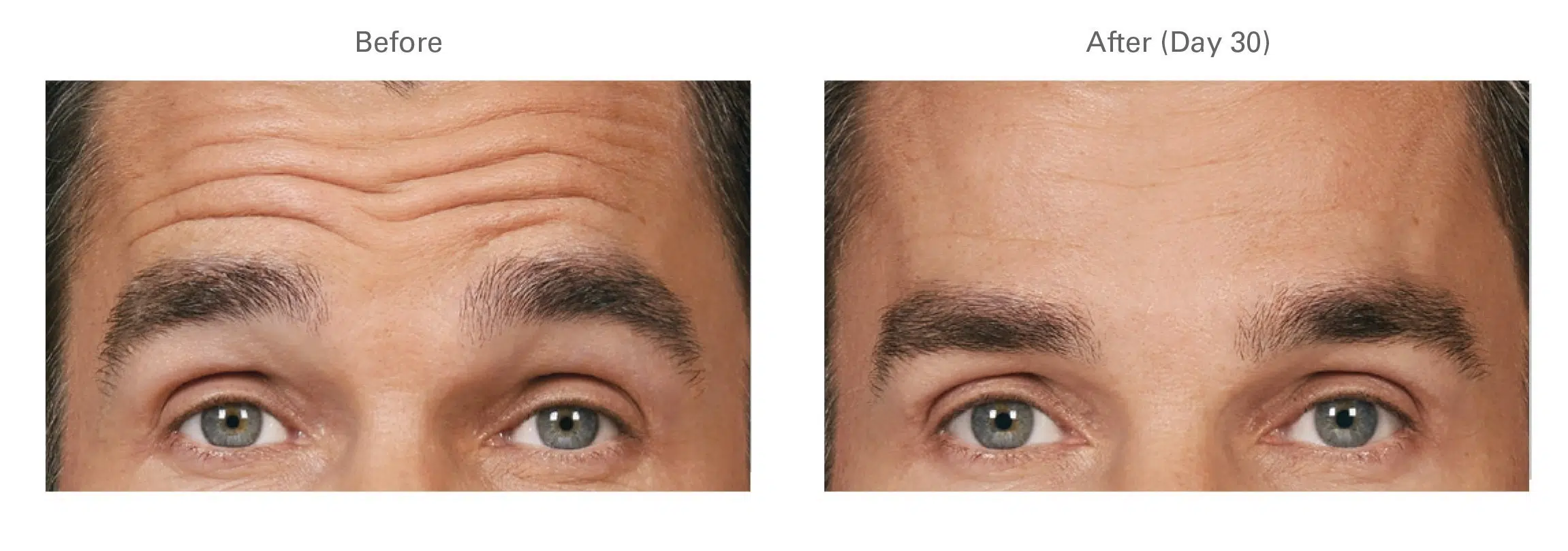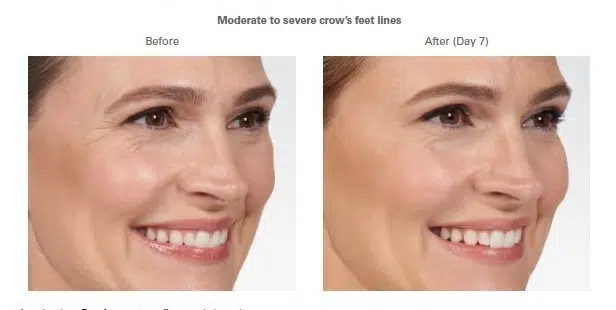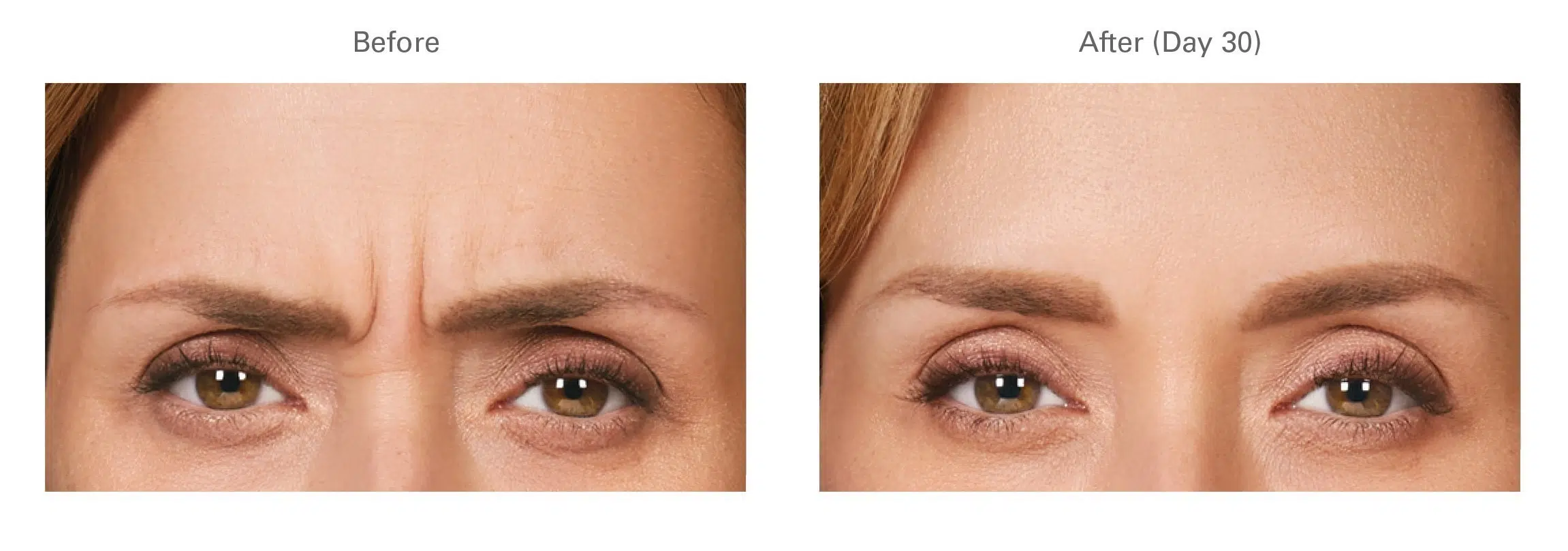Toronto Botox Clinic NEAR ME
Skin Vitality is the #1 Provider of Botox® in Toronto!
Looking for Botox in Toronto? At Skin Vitality, we specialize in helping clients look refreshed and feel confident — without surgery or downtime. Whether you’re smoothing fine lines, softening forehead creases, or tackling wrinkles around the eyes, our expert medical team delivers safe and subtle results using clinically proven Botox treatments.
As the #1 provider of Botox in Canada, we combine extensive experience with personalized care to ensure every visit is seamless and effective. Our Botox treatments are quick, with minimal discomfort, and perfect for anyone wanting a more youthful appearance without interrupting their daily routine.
Curious about how Botox could work for you? Book a FREE consultation today and let’s create your personalized plan.
TOP BOTOX CLINIC IN TORONTO
Skin Vitality is proud to be one of the top destinations for Botox in Toronto — trusted by thousands of clients seeking effective, natural-looking results. We understand that facial rejuvenation isn’t one-size-fits-all. That’s why our licensed professionals take the time to tailor each Botox treatment to your unique facial anatomy and aesthetic goals.
From treating crow’s feet and frown lines to restoring smoother skin across the forehead or brow, Botox is a trusted option with proven results. Our clients often start seeing visible improvements within days, with full effects appearing in about two weeks and lasting up to four months.
Discover a more confident, refreshed version of you, without looking overdone.
Botox NEAR ME
You can find Botox at all 14 Skin Vitality clinics. Skin Vitality Toronto is located at 351 Eglinton Ave W, Toronto, ON M5N 1A3.
Our Toronto Botox injectors are:
- Leaders in the field of cosmetic injectables treatments, selected based on credentials and professional reputation.
- Highly experienced in performing the treatment, which they build on every day.
- Continuing to enhance their knowledge with additional hands-on training.
- Able to treat a wide variety of aesthetic and medical concerns with the application of Botox®.
Botox Testimonial
Patient REVIEWS

SHOP OUR EXCLUSIVE OFFER ON GIFT CARDS!
Easy to order, packaged in a fabulous gift box! Or choose to send an eGift Card online directly to the recipient!
Get up to $200 back with SV Gift Cards.
Treatment Areas
Botox is able to provide a wide range of fantastic treatment options that all work to make patients look great and, more importantly, feel more comfortable in their own skin. This treatment has a growing number of uses, Botox can ease muscle spasms (for example, spastic responses from cerebral palsy), flatten wrinkles and modifying your jawline! There are currently over 20 different medical conditions that clostridium botulinum toxin is being used to treat, with more being discovered regularly.
These are the issues our talented Botox injectors have been extensively trained to treat at Skin Vitality Medical Clinic:
BOTOX FOR THE Face:
- Brow Lift
- Bunny Lines (Scrunched Nose Wrinkles)
- Crows Feet
- DAOs (Depressor Anguli Oris Muscle)
- Lip Flip - Downturned Lips
- Forehead Lines
- Glabellar Lines (Angry 11's)
- Gummy Smile
- Lip/ Smokers Lines
Other Areas:
- Neck Bands (Platysmal Bands)
- Masseters
- TMJ
- Hyperhidrosis
Masseter Botox in Toronto
Looking to refine your jawline, ease tension, or achieve a slimmer facial contour? Masseter Botox at Skin Vitality Toronto offers a non-surgical solution for both aesthetics and wellness. By carefully injecting Botox into the masseter muscle — the powerful jaw muscle responsible for chewing — we can help relax overactive muscle activity, soften a square jawline, and relieve symptoms of jaw clenching or TMJ.
Whether you’re hoping to create a more contoured, V-shaped appearance or reduce discomfort from teeth grinding, masseter Botox is a versatile treatment trusted by thousands across Canada. The treatment is quick, with no downtime, and visible results can be seen in just a few weeks as the muscle gently slims over time. Want to learn more about Masseter Botox? Click here.
If you’re searching for trusted masseter Botox near me, or want to see what real results look like, our experienced Toronto medical team is here to guide you. Book a free consultation today to learn how Botox on the masseter can work for your face, function, and confidence.
Botox Lip Flip
Prepare to experience a beauty revolution as we dive into the world of the Botox lip flip, the non-surgical technique redefining lip enhancement with minimal effort and maximum impact.
Designed to create the illusion of a fuller, more shapely pout without adding volume, the Botox lip flip involves precise injections around the upper lip to relax surrounding muscles, causing the lip to subtly roll outward.
It’s a game-changer for those looking to soften a gummy smile, enhance their natural lip line, or simply elevate their look with a softer, more natural result. With no downtime, minimal discomfort, and results visible within days, the Botox lip flip is quickly becoming a go-to choice for anyone ready to take their smile to new heights. Curious about what it can do for you? Explore real lip flip results at Skin Vitality — or book a complimentary consultation to get started.
Botox Lips
Picture this: your lips, transformed into a work of art, subtly enhanced to achieve a fuller, more sensual appearance. The Botox lip flip works by relaxing the muscles around the mouth, allowing the upper lip to gently roll outward, revealing a beautifully enhanced cupid’s bow. It’s like a flick of a magic wand that adds an irresistible touch of allure to your smile.
But that’s not all! The Botox lip flip also works its magic by minimizing the appearance of fine lines and wrinkles around the mouth. It’s a double whammy of beauty benefits, offering both a plumper pout and a more youthful, smoother appearance. Say goodbye to those pesky lip lines and hello to a rejuvenated, vibrant smile that defies the passage of time!
And here’s the best part: the Botox lip flip is a quick and virtually painless procedure that delivers results in no time. With a simple injection, expertly administered by a skilled professional, you’ll witness your lips transform into a masterpiece right before your eyes. It’s a truly remarkable experience that leaves you feeling empowered, confident, and ready to conquer the world!
So, if you’ve ever dreamed of having the perfect pout that radiates charm and captivates all who behold it, the Botox lip flip is your ticket to lip paradise. It’s time to embrace the power of your smile, indulge in a touch of glamour, and unlock the secret to irresistible lips. Get ready to pucker up and let your beauty shine with the Botox lip flip!
Want to know everything about a Botox Lip Flip? Click here for more information!
Lip Flip vs Filler
If you’re curious about enhancing your lips without committing to full dermal filler, a lip flip could be the subtle solution you’ve been looking for. Unlike fillers that add volume by injecting hyaluronic acid into the lips, a Botox lip flip uses a few quick injections to relax the muscles around the mouth — allowing the upper lip to gently “flip” outward for a fuller, more defined look. It’s ideal for those who want to create the illusion of more volume, improve lip shape, or reduce a gummy smile — all without adding filler.
Choosing between a lip flip and filler depends on your goals. While fillers provide structure and plumpness, a lip flip enhances lip show and curvature. Not sure which is right for you? Book a free personalized consultation at Skin Vitality and let our expert team guide your decision with care and confidence.
How Does Botox work?
Botox Cosmetic contains onabotulinum toxin A. Botox is able to intercept signals being sent from the nerves to the muscles and stop them, halting muscle contractions and causing a relaxation of the targeted area. When this substance is injected, how it works is by simply relaxing the facial muscle underneath the skin to create a smooth and refreshed appearance. Botox is approved by the FDA and Health Canada for the treatment of crow’s feet (those wrinkles that extend from the outer corners of your eyes, and appear most often when you smile or squint) and glabellar lines (the vertical creases between your eyebrows, most prominent when you frown). These are called Botox 11 lines.
Watch This Quick Video ON HOW BOTOX WORKS!
Founded in 1992, Skin Vitality Medical Clinic has 14 Locations across Southeastern Ontario. Our Medical Team consists of over 200 professionals including 10 Medical Doctors, 40 Nurse Practitioners and dozens of Registered Nurses and Registered Practical Nurses. We are the Largest Provider of Botox®, Juvederm®, CoolSculpting®, Hair Restoration®, Sculptra®, EMSculpt® and Fraxel® in Canada.
What is Botox?
Get ready to dive into a journey that will transform the way you look and feel; the enchanting world of Botox! Botox, the epitome of age-defying beauty, is here to revolutionize your appearance and unlock a level of confidence you’ve only dreamed of. But what exactly is this miraculous treatment that has captivated the hearts of millions? Let’s uncover the secrets of Botox and discover why it’s the ultimate game-changer!
At its core, Botox is a remarkable neurotoxin derived from the bacterium Clostridium botulinum. But don’t let the scientific vocabulary intimidate you! In the skilled hands of a qualified professional, Botox is transformed into an elixir of beauty that rejuvenates your skin and is able to turn back the hands of time. It’s a true testament to the wonders of modern science and the power of innovation.
So, how does Botox work its magic? Botox is injected into specific muscles, where it temporarily relaxes them, reducing their ability to contract. This relaxation smooths out wrinkles and fine lines, resulting in a more youthful, refreshed appearance. It’s like a reset button for your face, restoring your natural beauty and giving you a newfound radiance.
What Can Botox Be Used For?
Here’s the best part: Botox is not just for the face! It can also be used to address various medical conditions, such as migraines, excessive sweating, and muscle spasms. It’s a multi-purpose wonder that offers relief and improves your overall quality of life. Botox truly is a gift that keeps on giving, delivering both cosmetic and therapeutic benefits.
Botox is the epitome of age-defying beauty, an elixir that revitalizes your appearance and unlocks a newfound confidence. It’s a scientifically advanced treatment that offers transformative results, targeting wrinkles and fine lines with precision and efficiency. Whether you’re seeking a subtle enhancement or a dramatic transformation, Botox is the ultimate tool in your beauty arsenal. The power of Botox unlocks a world of timeless beauty that will leave you feeling radiant, empowered, and ready to conquer the world!
Read about the Top 5 Botox Don’ts.
How Much is Botox?
Are you ready to embark on a journey to unlock the secret to timeless beauty? Look no further, because Botox is here to revolutionize your appearance and take years off your face! Picture yourself with smooth, wrinkle-free skin, radiating a youthful glow that turns heads wherever you go. But wait, you must be wondering, how much does this miracle treatment cost? Well, let me tell you, it’s worth every penny!
How Much Does Botox Cost?
While it is not possible to know the exact cost before consulting with a licensed practitioner, it can be assured that the cost of Botox is a small price to pay for the transformative results it delivers. It’s an investment in yourself, in your well-being, and in your future. Think about it: how much is the priceless feeling of self-assurance truly worth? The priceless smiles and compliments you’ll receive? The newfound vitality that shines from within you? It’s time to consider the immeasurable value that Botox brings to your life.
But wait, there’s more! Botox isn’t just about erasing lines and wrinkles; it’s also a preventive measure against the relentless march of time. By targeting and relaxing the underlying muscles, it helps prevent the formation of future wrinkles, keeping you looking eternally youthful. It’s like pressing the pause button on aging, allowing you to savor each precious moment with confidence and grace.
Benefits of Botox
Moreover, the benefits of Botox extend beyond its cosmetic wonders. It can help alleviate certain medical conditions, such as migraines and excessive sweating, offering relief and improving your overall quality of life. By choosing Botox, you’re not only investing in your outer beauty but also in your inner well-being.
So, while I can’t provide you with a specific cost, I can guarantee you that the value of Botox far exceeds any monetary figure. It’s an opportunity to unlock your full potential, radiate confidence, and rewrite the story of your life. Embrace your beauty, and dare to explore the limitless possibilities that Botox holds. Investing in Botox in return allows for a remarkable journey of self-transformation!
Botox Consultation
Botox, the coveted elixir of the stars, offers an investment that goes beyond simple aesthetics. It’s a gateway to renewed confidence, boosting your self-esteem and empowering you to conquer the world. Imagine stepping into every room with an air of magnetic allure, effortlessly captivating everyone around you. With Botox, you can make a lasting impression that transcends time.
How Long Does Botox Last?
Botox is an amazing treatment that allows you to step into a world where time stands still and beauty knows no bounds. It is the ultimate weapon against aging, and offers you the closest thing to eternal youth, and who doesn’t want that? But you might be wondering, how long does this magical transformation actually last?
When it comes to the duration of Botox, the effects are simply awe-inspiring. An exact timeframe is hard to be predicted, but it can be promised that the results are nothing short of remarkable and can last for a few months. Imagine bidding farewell to those stubborn wrinkles and crow’s feet for an extended period, as if time itself has been rewound. With Botox, you can revel in the bliss of looking and feeling years younger!
Botox Effects
Botox not only offers instant rejuvenation but also works its magic over time. As you continue with your Botox journey, you’ll notice that the results can become even more impressive with each session. With regular treatments, you can achieve a cumulative effect that keeps you looking perpetually vibrant and radiant.
Now, I know what you’re thinking: “Will I need to go under the needle every few weeks?” Fear not! Botox provides a lasting solution that lets you embrace life to the fullest. While individual experiences may vary, the effects of Botox typically endure for a substantial period, allowing you to relish in your newfound beauty for months on end. It’s like having the fountain of youth at your fingertips!
Furthermore, Botox’s longevity is influenced by various factors, such as your metabolism, lifestyle choices, and the specific areas treated. The expert guidance of a skilled professional here at Skin Vitality will ensure that you receive personalized care, maximizing the longevity of your results. So, rest assured, your journey towards beauty is in capable hands!
How Long Does it Take for Botox To Work
Are you ready to witness a miraculous transformation unfold before your very eyes? Botox is about to revolutionize the way you look and feel! But you must be wondering, how quickly does this wonder treatment work its magic?
While individual experiences may vary, Botox typically starts to work its magic within a matter of days. That’s right, in just a short span of time, you’ll witness the remarkable effects unfold before your very eyes!
As the days pass, you’ll notice those stubborn lines and wrinkles gradually fade into the realm of distant memories. Botox targets the underlying muscles, gently relaxing them to unveil a smoother, more youthful appearance. It’s like a magic wand that erases the signs of aging, leaving you looking and feeling revitalized!
But wait, it gets even better! Botox’s transformative powers continue to evolve over time. With each passing week, the full impact of the treatment unfolds, revealing a radiant, rejuvenated version of yourself. It’s as if you’ve discovered the elixir of eternal youth!
So while I can’t pinpoint the exact timeline for your personal Botox journey, I can promise you that the results are worth the wait. In a matter of days, you’ll witness the initial metamorphosis, and with each passing week, the effects will ameliorate and sustain.
Why Choose Skin Vitality?
- The Lowest Botox Prices in the Country with the Best Possible Results!
- Most Experienced Medical Professionals with the Most Specialized Extensive Training
- Open 9am to 8pm Monday to Friday and Saturdays until 5pm!
- 14 Locations Across the GTA and Surrounding Area
- Proudly Serving Canadians Since 1992
- Over 200 Staff Including 10 Doctors and 50 Nurses
- Free Assessments with our Medical Professionals
- 100% Certified Botox® Cosmetic
- State-of-the-Art Facilities
- Health Canada and FDA Approved
- Five Star Testimonials / 96% Patient Satisfaction
FAQ's
Botox, short for Botulinum toxin, is produced by the bacterium Clostridium botulinum. It is utilized to temporarily relax muscles, resulting in reduced fine lines and wrinkles within your appearance. Botox is commonly used to smooth facial lines, particularly in the forehead, around the eyes, and between the eyebrows. Additionally, Botox has various medical uses as well.
If interested, please contact us today for a FREE consultation and personalized assessment.
Botox Cosmetic contains onabotulinum toxin A. When this substance is injected, how it works is by simply relaxing the facial muscle underneath the skin to create a smooth and refreshed appearance. While this only targets the wrinkles that appear when you make facial expressions, you can consider getting an injectable filler treatment with hyaluronic acid at the same time for any wrinkles and creases that are permanently visible.
Feeling nervous about your initial Botox treatment is common, but with adequate preparation, there’s no need to worry. This non-invasive injection involves administering Botox to specific areas of concern, with the sensation resembling a mild insect bite, and lasting 10-20 minutes.
Results typically appear within 72 hours (about 3 days), reaching full effect in up to 2 weeks. Patients are encouraged to evaluate results after two weeks, whereas a follow-up appointment can be scheduled for a thorough review.
Botox results take effect for the next three to four months, preventing muscle movement during this period. The effect gradually diminishes, returning to normal muscle function around six months after treatment. Regular appointments every three months can extend the duration of results. Botox Cosmetic is not permanent, and the muscle-contracting ability responsible for frown lines is restored within two or three days after injections.
Botox Cosmetic will stay local to the muscle where it was injected. However, there is a very minimal risk of migration, particularly if the treated area is rubbed or excessively touched immediately after your injection. For that reason, it’s best to avoid touching the area in the first few days.
After your Botox Cosmetic treatment, the product is simply metabolized and broken down into a natural by-product in the weeks and months after your injection.
The cost of each Botox treatment varies by patient and only a personal consultation can give you a more specific amount. The cost can range from $100 and up depending on the amount of Botox injections required and the area being treated.
During your consultation, it’s advisable to bring questions about Botox treatment. As it is a prescription drug, a licensed physician will discuss your treatment goals and provide details about the procedure day. The targeted area will be assessed to ensure you are a suitable candidate for Botox.
While Botox is generally very safe, potential side effects (commonly swelling and temporary discomfort from the injection) will be explained, and your injector will guide you on managing any issues. Preparing for treatment may involve avoiding blood-thinning medications a week prior, taking Arnica pills, and considering anti-inflammatory options like pineapple.
All Botox treatments are conducted by a certified medical injector, ensuring safety and privacy within our medical clinics. You have the flexibility to choose from any of our 14 locations across Ontario, based on your convenience. Our clinics are situated in Toronto, Mississauga, Oakville, London, Ajax, Richmond Hill, Kitchener, St. Catharine’s, Milton, Burlington, Stoney Creek, Hamilton, Whitby, & Barrie.
The results of Botox typically begin to appear within a couple of days post injection. However, the full results may take up to 2 weeks to develop, so it is important to wait an adequate amount of time before seeking a touch-up treatment.
After using Botox continuously for years, your muscles will become trained not to make wrinkle-forming expressions as aggressively. This is great because even after Botox wears off, there can be lasting effects that prevent the formatting of wrinkles that are responsible for the look of old age.
During your initial Botox treatment, your injector will review your medical history, address concerns, and mark targeted areas of concern. The procedure, lasting 10-20 minutes with a fine needle to minimize discomfort, is followed by before-and-after photos to track progress.
The Botox injections feel very similar to a small insect bite, with many patients explaining there is some mild discomfort, but it is not painful. Speak to your medical injector about a topical numbing cream prior to your treatment if you have a lower pain tolerance. Full effects take 24-72 hours, with results assessed after one to two weeks. A follow-up appointment with your injector can be scheduled accordingly to review your full results.
Botox treatments are personalized for each patient, considering factors like facial structure, eyebrow shape, and forehead dimensions. Our experienced medical injectors at Skin Vitality use specific techniques to achieve natural results, tailoring the approach to diverse backgrounds. Botox is most effective for those without a history of neuromuscular diseases, mentally and physically healthy adults willing to handle the potential mild side effects.
Ideal candidates understand the treatment’s limitations, such as its effectiveness in addressing permanent creases or adding volume and manage realistic expectations. Results vary, requiring patience and follow-up sessions for desired outcomes. An ideal Botox candidate should be patient and willing to undergo follow-up sessions that allow them to enjoy the results they desire.


